The Great War Centenary: Part Four, Ottomans and Gallipoli
The first battles of the First World War were being fought in the first week of August 1914. At the same time events affecting the future of the Ottoman Empire were unfolding...
This is Part Four of a series of posts leading up to the centenary of the end of The Great War on November 11, 2018. For details of the German plan and execution of the invasion of Belgium and France, please see The Great War Centenary: Part Three, Invasion.

The Ottoman Empire declares war, 28 October 1914
Piracy
On the eve of the First World War, the once-mighty Ottoman Empire was on the verge of collapse. Its people were demoralised and tired. It had suffered from the many wars fought in this period. It had lost territories and its economy was in shambles. However, the Turkish people enthusiastically contributed to a public fund to purchase two Dreadnought battleships to be built by Britain. They were to be given the names Reshadie (gift) and Rashad I. Hamiss.
The first ship was launched on 3 September 1913 but the building of the second was abandoned for lack of funds. But when Brazil was unable to pay for the ship it had ordered, it was offered to the Turks who made the payment. It was named Sultan Osman. The ships were ready to sail on 29 July 1914 — to great anticipation from the Turkish people.
But at the last minute, Winston Churchill, then First Lord of the Admiralty, decided that the ships should be confiscated. In light of war being declared in Europe, he determined that the British Navy required the ships and that Turkey's allegiance couldn't be trusted. At this stage, Turkey and its Ottoman Empire were strictly neutral.
The Turkish people were outraged. After all, the ships had been paid for by Turks from all strata of society, even the very poor. This “act of piracy”, as Barbara Tuchman calls it, shifted the weight of support from neutralism towards an alliance with the Triple Alliance (Germany, Austria-Hungary and Italy), as advocated by the Turkish Minister of War, Enver Pasha.
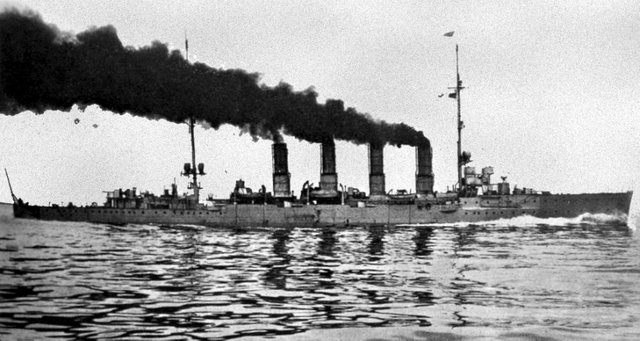
SMS Breslau
The Goeben and The Breslau
Two German warships, Goeben and Breslau, were under repair on the Adriatic coast when war broke out between Austria-Hungary and Serbia on 28 July 1914. Not wanting the ships to be caught there, the repairs were rushed and left uncompleted as they hastily sailed to the Mediterranean.
Meanwhile, war had broken out between France and Germany and the French were desperately trying to get all available troops to the front to face the million-man German armies. A large transport operation of troops from Northern Africa was underway and Churchill had ordered the British fleet in the area to guard the French ships.
The German ships sailed into this fray to try and disrupt the operation. And then on the morning of 4 August 1914, they came face-to-face with two British Navy battle-cruisers, Indomitable and Indefatigable.
There was no battle since Britain was not at war. Its ultimatum to Germany over her invasion of Belgium would only expire at midnight — about 14 hours away. Indomitable and Indefatigable tried to follow the Germans but they couldn't keep up, and Goeben and Breslau slipped into the night.
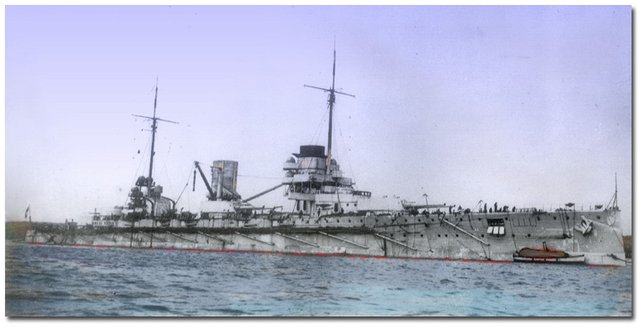
SMS Goeben
Goeben was fast running out of fuel and headed to an Italian port to coal-up. But it was refused entry even though Italy was supposedly in alliance with Germany, and had decided to remain neutral. The two ships met up and managed to get coal from a supply ship.
The British thought they would either return to harass the French fleet or try and join the German fleet in the North Sea. But the Germans had orders to sail east to Constantinople. On 6 August they encountered Gloucester, a cruiser which was no match for the powerful German ships. It tried to follow Goeben and Breslau, but this was called off when the Admiralty thought they would not be heading for the Dardanelles and Constantinople since Turkey was neutral and was bound not let a belligerent warship in.
Constantinople
The Turkish navy escorted the German warships in, as authorised by War Minister, Enver Pasha. But how to deal with the issue of Turkish neutrality? The answer was for the Germans to “sell” the ships to the Turks.
It was a touch of genius from the Germans. The Turks were still seething from the theft of their ships, and here was a gift of two powerful warships. It was perfect propaganda: the Germans had come to their aid after the British had backstabbed them.
Goeben and Breslau were renamed respectively Yavuz Sultan Selim and Midilli. The crew were given fezzes and their commander, Wilhelm Souchon, was made commander-in-chief of the Ottoman Navy. On 29 October Souchon entered the Black Sea with Yavuz Sultan Selim and Midilli and a squadron of Turkish warships and launched the Black Sea Raid against the Russia, bombing Sevastopol.
On 1 November, Russia declared war on the Ottoman Empire, and the Central Powers were no longer outnumbered. Historians agree that this extended the war by at least two years. It also led to the complete collapse of the Ottoman Empire once the war was lost. The allies carved up the collapsed Ottoman Empire. Many new nations were created including Syria, Lebanon, Saudi Arabia and Iraq, and the idea of a Jewish state in Israel was considered for the first time.
Churchill's seizing the Turkish ships turned out to be a historic mistake. We are still living with the consequences today.
Gallipoli
With the Ottoman Empire now in alliance with Germany and Austria-Hungary, Cairo and the Suez Canal in the Middle Eastern had become their potential targets. Troops from Australia and New Zealand, known as the ANZAC forces, were in Egypt, training for trench warfare on the Western Front. So instead of moving them after training, they were retained to protect the area.
In February 1915 planning had begun on a naval operation to take Constantinople and defeat the Turks. On 18 March a fleet of 18 battleships accompanied by an array of cruisers and destroyers began the main attack against the narrowest point of the Dardanelles. When this area was deemed to be clear, the fleet proceeded into the straits. One after another the ships were badly damaged or sunk after hitting mines. A general recall was ordered.
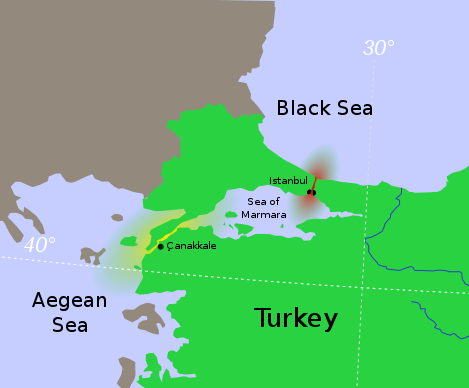
Planning then began on a landing of troops to eliminate the Ottoman mobile artillery which was preventing minesweepers to clear the way for larger vessels. Lord Kitchener appointed General Sir Ian Hamilton to plan and command the operation. He diverted French and British troops from the Western front to join the ANZAC forces in Egypt. Hamilton chose to concentrate on the southern part of the Gallipoli peninsula where an unopposed landing was expected. He had a very low opinion of the Turkish forces, believing they were not a threat.
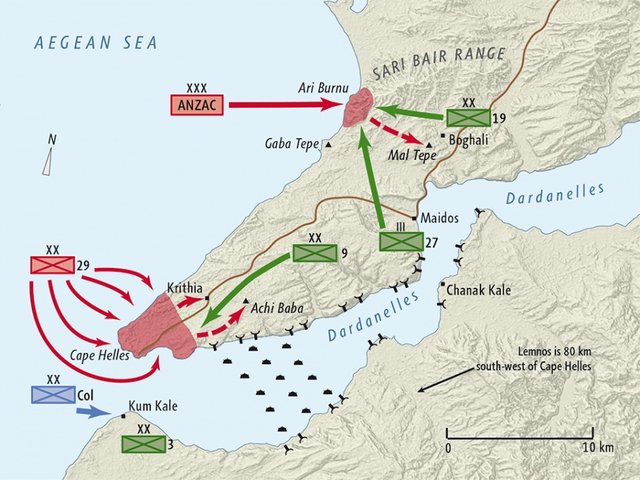
There were to be two main landing sites: at Cape Heller in the South and at an area north of Gaba Tepe. The idea was to drive Ottoman troops from the South, who would then be cut off by the Allied forces in the North. They expected it to be a quick and easy operation. Kitchener had a low opinion of British colonial forces. When asked if he thought the Anzac's “were good enough” for the operations, he dismissively replied: “they were quite good enough if a cruise in the Sea of Marmora was all that was contemplated.”
The landings
On 25 April 1915, ANZAC troops landed one mile further north than planned. It was night and in the darkness, the landing boat formation got mixed up. When they landed, instead of the expected open ground, they were met with steep cliffs and ridges. In the confusion, while the officers tried to work out their location, they came under small arms fire. The struggled up the cliffs, using their bayonets to dig into the soil.
The place where they landed would become known as Anzac Cove.
In the morning more troops arrived, this time under fire from the Ottomans. Troops were killed in the landing boats and the beach. Then the Turkish artillery bombarded the beachhead, destroying at least six boats. But still, the Allied troops pressed on up the steep terrain, trying to take the high ground. Late in the afternoon the Turks holding the crest ran out of ammunition and began to withdraw.
As some Australian troops approached the crest, Turkish divisional commander, Lieutenant-Colonel Mustafa Kemal, managed to reach his retreating troops. He ordered them to halt, and since they had no ammunition, they had to fix bayonets, lie down and face the enemy. This confused the Australians and they stopped and also lay down. This bought Kemal some time for one of his top regiments to get in position before the Australians reached the ridge. Kamal realised that if his forces did not hold the ridge, then the whole position on the Gallipoli Peninsula might be lost.
One Turkish and two Arab regiments poured in and a fierce battle continued for the rest of the say. Wave after wave of Ottomans threw themselves down on the Anzacs. As they were mowed down by machine-gun fire, more men climbed over the bodies to do the same. The Ottomans held onto the crest and the Anzacs held the western slopes.
The Anzacs called for evacuation but General Hamilton refused this saying the troops from the South would soon relieve them. This was far from the truth.
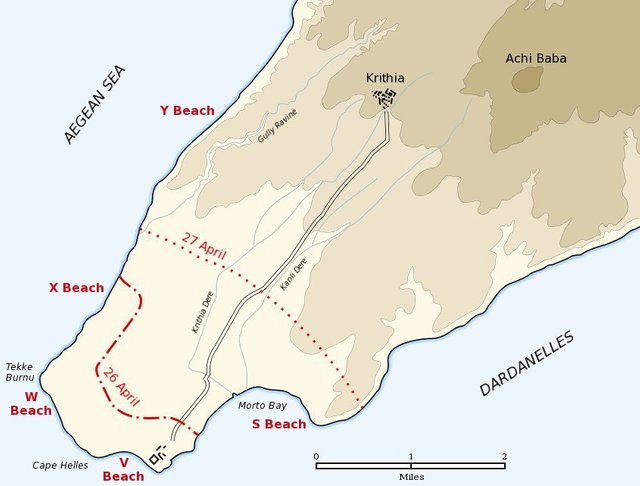
Cape Helles landing beaches
In the South, the Lancashire Fusiliers landed at 'W' Beach in open boats, on a shore overlooked by dunes and obstructed with barbed wire. A preliminary bombardment of the area was supposed to have removed any defenders and destroyed the barbed wire. Neither of these happened. The Ottoman defenders were hidden, sitting in silence. As the soldiers jumped off the boats and ran up the beach the defenders swept the beach with machine-gun fire The men in the boats were so tightly packed in that the dead remained sitting. Many drowned as they leapt into the too-deep water, weighed down by their heavy packs. The barbed wire too killed many men. Eventually, the Lancashires were able to overwhelm the defenders, but at a terrible cost. They had a loss of 600 casualties from 1,000 men, a 60% casualty rate.
'W' Beach would become known as Lancashire Landing. Six awards of the Victoria Cross were made among the Lancashires at 'W' Beach.
The aftermath
Recent figures give an estimate of about 57,000 Allied troops killed with a further 131,00 wounded or missing during the Gallipoli Campaign. Of these, the British took the most casualties (34,000 dead), followed by the French (10,00 dead) and the Anzacs (4,000 dead). Between 56,000 and 68,000 Ottoman men died.
The campaign was the only major Ottoman victory of the war. Mustafa Kemal, the man who held the ridge was hailed as a hero. He was named Atatürk, the founder of modern Turkey.
The campaign is often considered to be the beginning of Australian and New Zealand national consciousness. 25 April, the anniversary of the landings, is known as “ANZAC Day”, the most significant commemoration of military casualties and veterans in the two countries, surpassing Remembrance Day (Armistice Day).
This series on World War One will be continued in Part Five, tomorrow
Previous post in this series:
The Great War Centenary: Introduction.
The Great War Centenary: Part One, The Tinderbox
The Great War Centenary: Part Two, The Spark
The Great War Centenary: Part Three, Invasion
References:
The Guns of August, Barbara Tuchman
https://www.britishcouncil.org/voices-magazine/why-turkey-hasnt-forgotten-about-first-world-war
https://en.wikipedia.org/wiki/Pursuit_of_Goeben_and_Breslau
http://www.thenagain.info/WebChron/EastEurope/TurkeyCentral.html
https://firstworldwarhiddenhistory.wordpress.com/category/anzac/
https://en.wikipedia.org/wiki/Landing_at_Anzac_Cove
https://en.wikipedia.org/wiki/Gallipoli_Campaign
https://www.smithsonianmag.com/history/new-view-battle-gallipoli-one-bloodiest-conflicts-world-war-i-180953975/
Very well written @tim-beck, I was bound to my desk to finish this episode. Looking forward to the next.
Thanks, @johannvdwalt!
Interesting to learn strategies put in place, Winston Churchill played big part in both wars.
Also learned where and what Dardanelles represented my Fathers MOTH Shellhole name.
Interesting reading @tim-beck good to know where we came from, to know where we going, hopefully not into conflict on such a grand scale.
Your post has been selected to be entered into @teamsouthafrica's Daily Nominated Post section in Teamsouthafrica's Discord group. Congratulations!
Thanks for your support, @joanstewart. Apologies for not replying sooner, but quite honestly I was so exhausted after doing those posts I didn't have time for anything else.
Concise content takes a lot of time and effort, so much happened leading up to the war, much happened during, it was very well written into easy reading and understanding.
Yes, Winston Churchill seemed to get around wars, didn't he? You might recall he was also in the Boer war, where he was captured by the Boers and managed to escape.
He resigned after the Dardanelles disaster and actually went back to the trenches for a while before he was recalled in 1917 to be Minister of Munitions.
Some men develop exceptionally strong strategic insight, my father held some in high esteem Jan Smuts was one who I believe worked quite closely to Winston Churchill. My Dad was born in 1911 his father arrived in Africa with the Boer war.
That's almost an exact snap! My Dad was born in 1910 and his father arrived on the outbreak of the Boer war. Amazing
Congratulations! Your post has been selected as a daily Steemit truffle! It is listed on rank 25 of all contributions awarded today. You can find the TOP DAILY TRUFFLE PICKS HERE.
I upvoted your contribution because to my mind your post is at least 8 SBD worth and should receive 130 votes. It's now up to the lovely Steemit community to make this come true.
I am
TrufflePig, an Artificial Intelligence Bot that helps minnows and content curators using Machine Learning. If you are curious how I select content, you can find an explanation here!Have a nice day and sincerely yours,

TrufflePigGreat read @tim-beck. Thank you
Thanks, @fionasfavourites. Glad you enjoyed it.